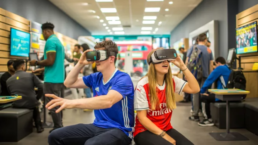Virtual reality headsets are fast becoming the latest trend in the sporting sphere, offering fans some amazing new experiences that connect them to their chosen sport.
VR sales are on the rise. Over 2.1 million augmented and virtual reality headsets have been shipped in the second quarter of 2017 – a 25.5% increase from 2016. Virtual reality products are making up 98% of those shipments.
If you haven’t tried on a VR headset, I’m sure you’ve seen the videos of people becoming immersed in the virtual world. If you haven’t, check this out. Reactions to the headsets suggest VR really does make the user believe they’ve been transported to a new world.
Applying this technology to the sports industry sounds like an easy win. But does it work in practice?
VR IN THEORY
Some famous football teams are now bringing out their own VR apps. Juventus F.C. released theirs on October 12th, 2017. Juventus VR allows viewers behind the scenes, such as joining players in the locker room for team talks and, most importantly, it allows users to live-stream matches.
With 80% of Juventus’ 50 million followers living outside of Italy, Juventus VR allows far-away fans to travel to matches without moving at all. This helps break down geographical barriers – something all sports aim to do. Platforms like this are an excellent way of appealing to younger, tech-savvy fans and increasing the clubs’ fan base.
One of the most appealing aspects of technology like this is the ability to get the best seats in the house. To see your favourite players up close and watch the action unfold all from the comfort of your own home. This is currently the most realistic way of experiencing a game without actually being there, not to mention you don’t have to queue 20 minutes for a pint, the toilet, or eat the cost of ticket and travel.
VR IN PRACTICE
Nonetheless, despite numerous advantages, there are some drawbacks to the app. Juventus VR is free, however, it is only compatible with Oculus headsets which are sold from £300 to £400. Perhaps not an extortionate fee, but it is when you could watch the game through the TV for a fraction of the price. Also, for those families who bond over watching a game together, do you buy the whole family a £400 headset each?
It’s a nice idea, but doesn’t seem that practical. A key element of spectator sports is the collective emotion enjoyed through watching it with others. VR headsets will fundamentally minimise this experience.
Is watching football, baseball, boxing matches, or any other sport that much better in VR? From the sound of it, no, not really. Some users have even described it as ‘mundane’. Ouch. Money, development and investment have gone into making VR sport a concept, but 11.6% of people in a PwC report think that VR will suffer in sport.
Tech journalist Keith Nelson Jr. suggested watching baseball in VR is poor as ‘VR cams don’t zoom in, so diving centre-field catches and last-second slides into second (base) are virtually unwatchable in VR. Worst of all, in VR, you can’t watch a home run soar into the bleachers’.
WHAT DOES THIS MEAN FOR SPORTS?
VR is a great development for sports, but if it proliferates it will put pressure on rights holders to improve standards of entertainment at live events to ensure they maintain high attendance.
If more people own VR headsets, it will mean more people staying at home, no longer travelling to live events. It makes sense for some to watch the game from the comfort of their own home, whilst getting better seats than they ever would have if they’d bought tickets. This potential new reality will push live events to think of new strategies and activities to make the real thing far more appealing and entertaining.
Rights holders will create new, exciting live events in an attempt to entice fans to ditch the technology and still attend. Bigger and better ideas mean more money reinvested in sport, encouraging progress and improvement.
On the other hand, VR could improve to such an extent that it consumes live sports. This isn’t an impossible scenario.
Ultimately, despite some quality-related issues with watching sport in virtual reality, the innovation is moving in the right direction. VR and augmented reality technology will improve with time, and it will begin to penetrate other spheres of the sporting world.
The question is can sports use this technology to enhance their offering and not fully replace it? This is an exciting time for fans, clubs and players, so keep your eyes peeled for new developments.





